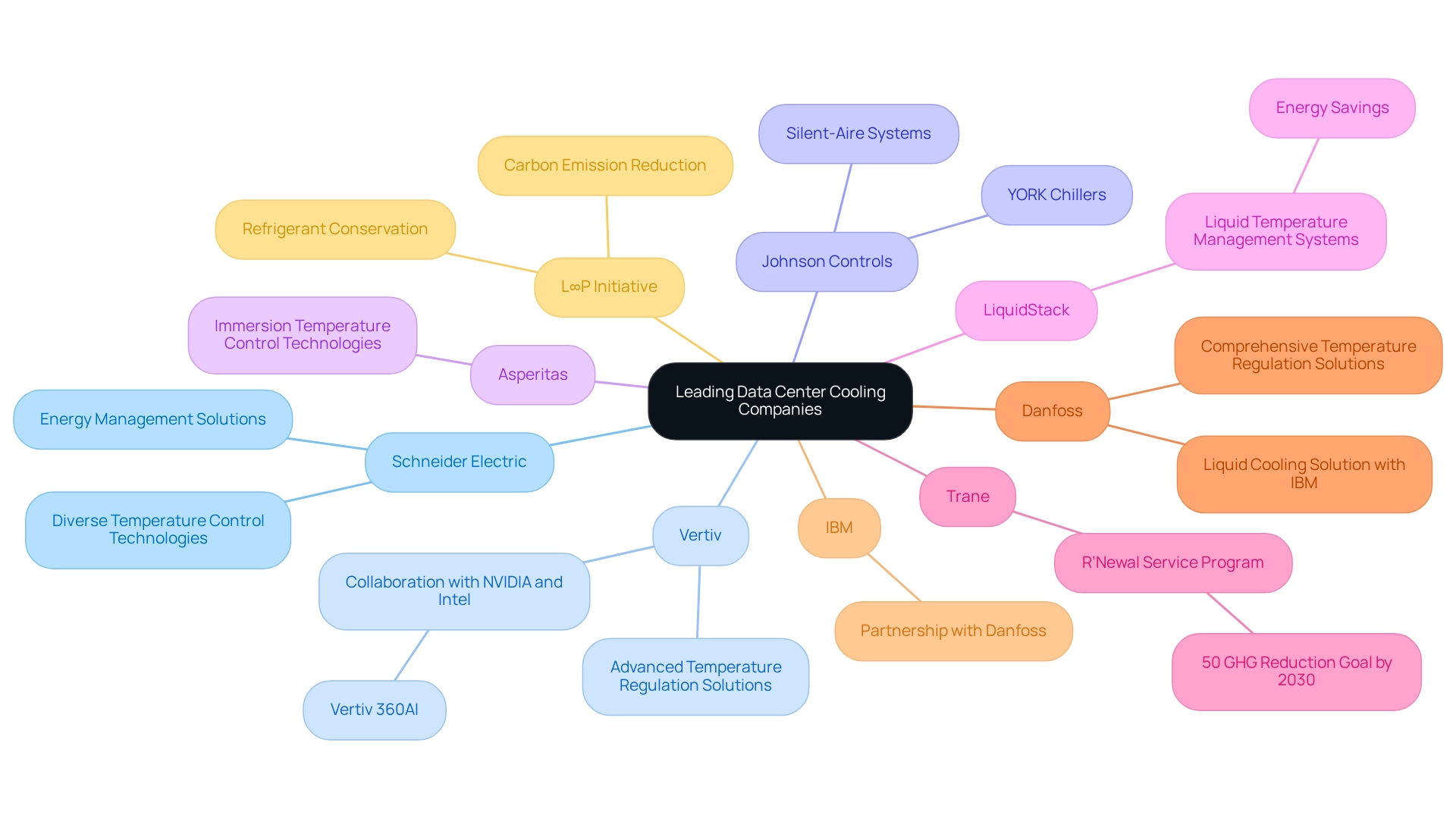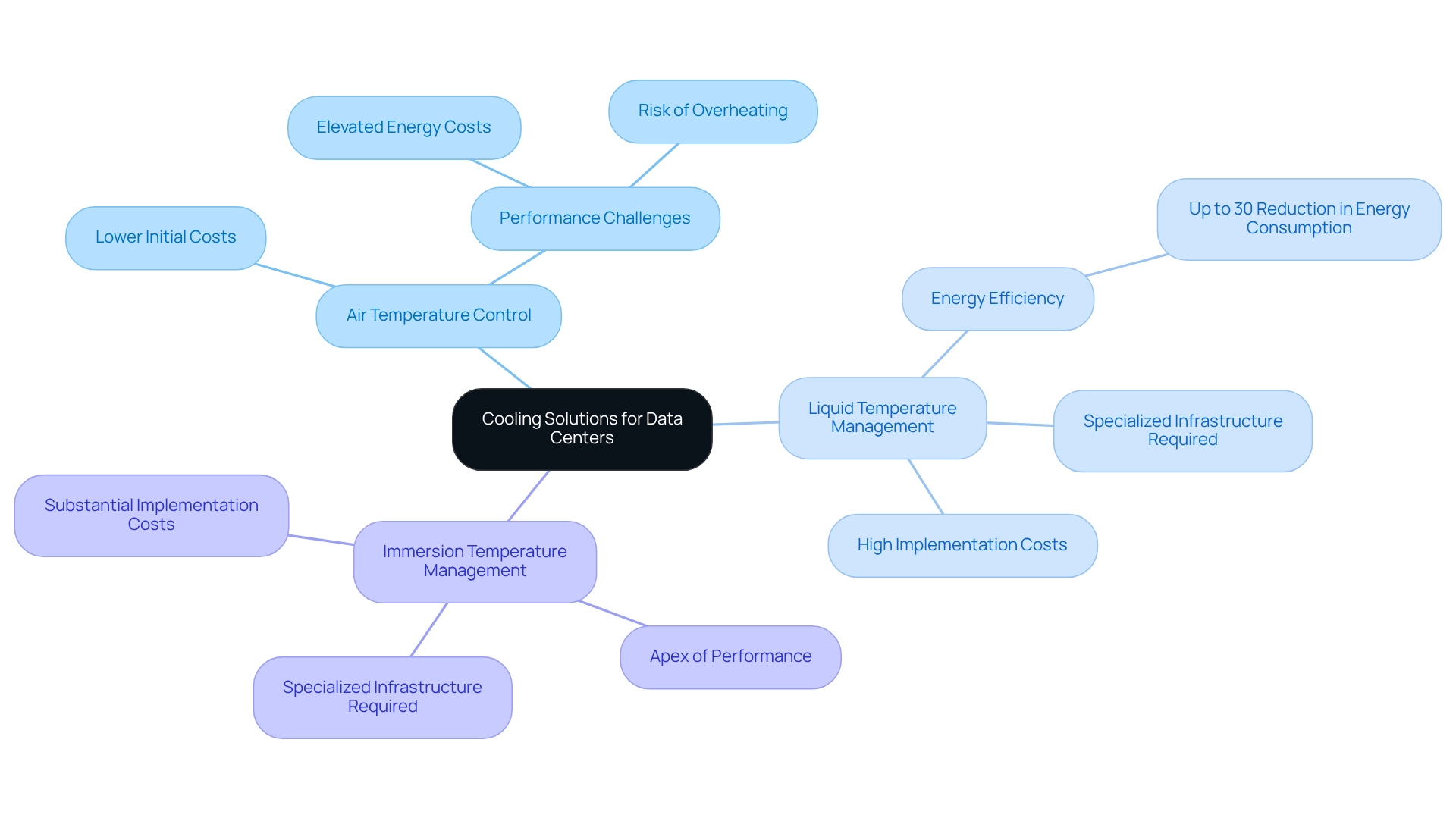Overview
Data center cooling companies are critically evaluating technologies and benefits primarily through three main cooling methods:
- Air circulation
- Liquid temperature control
- Immersion methods
Each of these approaches presents distinct advantages and challenges. While air systems are simpler to implement and maintain, liquid and immersion solutions are gaining traction due to their superior energy efficiency and performance, particularly in high-density environments. This trend reflects a significant shift towards more sustainable practices within the industry, underscoring the need for organizations to adapt and innovate in their cooling strategies.
Introduction
In the rapidly evolving world of data centers, effective cooling solutions have become paramount to maintaining operational efficiency and sustainability. Organizations are grappling with increasing server densities and energy demands, prompting leading companies like Schneider Electric, Vertiv, and Johnson Controls to pioneer innovative technologies that redefine cooling strategies.
From traditional air cooling systems to advanced liquid and immersion cooling solutions, each technology presents unique advantages and challenges. This article delves into the landscape of data center cooling, exploring the benefits and limitations of various cooling methods while highlighting the latest trends and innovations that are shaping the future.
As the industry moves towards enhanced efficiency and reduced carbon footprints, understanding these developments is crucial for organizations aiming to optimize their data center operations.
Overview of Leading Data Center Cooling Companies
In 2025, the data center temperature regulation sector is prominently shaped by key players such as Schneider Electric, Vertiv, and Johnson Controls. Schneider Electric is acknowledged for its innovative energy management solutions, providing a diverse range of temperature control technologies aimed at enhancing efficiency and sustainability. Vertiv excels in delivering advanced temperature regulation solutions specifically designed for high-density environments, ensuring optimal performance for critical digital infrastructure. In April 2024, Vertiv revealed its collaboration with NVIDIA and Intel to introduce Vertiv 360AI, highlighting its dedication to innovation in temperature control technology.
Johnson Controls leverages decades of HVAC expertise with its YORK chillers and Silent-Aire systems, delivering reliable temperature management solutions that meet rigorous demands. Furthermore, companies such as Asperitas are advancing with their immersion temperature control technologies, while LiquidStack focuses on liquid temperature management systems that promise significant energy savings. Notably, Trane’s R’Newal Service Program aims for a 50% decrease in greenhouse gas emissions by 2030, reflecting the sector’s movement towards sustainability. Danfoss offers a comprehensive solution for temperature regulation that emphasizes energy conservation and environmental impact. Their portfolio features several temperature regulation technologies and an innovative liquid temperature management solution created in partnership with IBM, leading to substantial enhancements in thermal capacity and energy effectiveness. Moreover, the L∞P initiative seeks to conserve significant quantities of new refrigerant and minimize carbon emissions, underscoring ongoing sustainability endeavors within the field. Each of these data center cooling companies plays a significant role in the evolving landscape of data facility temperature management, effectively responding to the increasing demand for improved performance and sustainable methods in the sector. As the market evolves, these companies are well-positioned to lead the charge in developing innovative solutions that align with the industry’s sustainability goals.

Comparative Analysis of Cooling Technologies and Features
Data centers primarily utilize three temperature regulation technologies: air circulation, liquid temperature control, and immersion methods. Air temperature control systems, while conventional, often face challenges in performance as server densities escalate. Conversely, liquid temperature regulation excels in thermal management by directly extracting heat from components, making it particularly suitable for high-performance computing environments. Immersion refrigeration takes this approach further by submerging components in a thermally conductive liquid, significantly enhancing temperature management and reducing energy consumption.
Each technology presents distinct characteristics:
- Air Refrigeration: Typically easier to implement and maintain, but less effective as server density increases.
- Liquid Refrigeration: Offers superior performance and energy savings, occupying less space than traditional air refrigeration alternatives, thus allowing for a more compact facility footprint.
- Immersion Refrigeration: Enhances the performance of information infrastructure, substantially lowering energy bills and carbon footprints.
Recent advancements underscore the benefits of immersion refrigeration, which not only enhances the performance of information infrastructure but also significantly reduces energy expenses and carbon footprints. As noted by industry specialists, immersion refrigeration bridges conventional and emerging server facilities, ensuring that AI processors operate at optimal temperatures, thereby improving performance and reliability. For instance, Motivair is focusing on developing innovative liquid temperature regulation technologies to meet the growing demand for effective thermal solutions as AI progresses.
The choice among these technologies ultimately depends on the specific requirements of the information hub, including size, power density, and temperature management capacity. There is an increasing trend towards liquid and immersion solutions as demands for efficiency and performance intensify. To summarize:
- Advantages of Air Circulation: Simplicity and ease of maintenance.
- Disadvantages of Air Circulation: Decreased effectiveness with higher server densities.
- Advantages of Liquid Circulation: Superior thermal management and space optimization.
- Disadvantages of Liquid Circulation: Higher initial costs.
- Advantages of Immersion Circulation: Exceptional temperature management and reduced energy use.
- Disadvantages of Immersion Circulation: Potentially greater complexity in implementation.
In conclusion, while air circulation remains a viable option, the increasing demands for efficiency and performance are driving a shift towards liquid and immersion technologies.
Benefits and Limitations of Each Cooling Solution
Air temperature control systems are prevalent in data centers due to their lower initial costs and straightforward installation. However, as server densities increase, these systems face significant performance challenges, leading to elevated energy costs and risks of overheating. In 2025, energy cost statistics indicate that air conditioning systems can result in substantial operational expenses, particularly in high-density environments where temperature control demands intensify. Sajjad Moazeni, an Assistant Professor of Electrical and Computer Engineering, notes that data centers can consume up to 1 GWh of energy daily, underscoring the operational implications of temperature regulation systems.
Conversely, liquid temperature management systems, while requiring a higher initial investment, provide considerable advantages in energy efficiency and temperature control performance. These systems can achieve energy consumption reductions of up to 30% compared to traditional air temperature regulation methods. Furthermore, the thermal utilization efficiency (TUE) improved by 15.5% from Study 1 to Study 4, showcasing advancements in temperature management technologies. Expert insights highlight that liquid temperature regulation is particularly beneficial in high-density data centers, according to data center cooling companies, where temperature management needs exceed the capabilities of air systems. Nonetheless, it is essential to acknowledge that liquid temperature regulation systems also have constraints, including the necessity for specialized infrastructure and potentially high implementation costs.
Immersion temperature management systems represent the apex of performance, proficiently managing extreme heat loads. However, they require specialized infrastructure and can lead to substantial implementation costs. Ultimately, the efficacy of each temperature regulation solution depends on the specific design, workload, and budgetary constraints of the facility, necessitating a customized approach to technology selection. In conclusion, while air temperature regulation systems offer lower initial costs, they face performance challenges; liquid temperature regulation systems provide superior energy conservation and effectiveness but demand larger upfront investments and specialized infrastructure.

Innovations and Trends Shaping the Future of Data Center Cooling
As we progress into 2025, the facility refrigeration environment is witnessing significant transformative trends. AI-driven temperature regulation solutions are gaining prominence, leveraging advanced analytics to enhance temperature management through real-time data examination. This evolution is further supported by the increasing adoption of heat reuse technologies, enabling computing facilities to repurpose waste heat for diverse applications, thereby significantly improving overall energy efficiency.
With U.S. electricity demand projected to rise by approximately 2% annually over the next 25 years, the urgent need for effective temperature control solutions provided by data center cooling companies is underscored. The sustainability movement is also propelling innovations in temperature control technologies, as organizations prioritize reducing their carbon footprints.
Notably, Vertiv has collaborated with Intel to introduce a liquid temperature regulation solution compatible with the cutting-edge Intel Gaudi3 AI accelerator, exemplifying industry cooperation in advancing temperature management technologies. Additionally, hybrid temperature regulation solutions that integrate both air and liquid methods are emerging, aimed at optimizing efficiency while managing costs.
Key players in the server facility temperature regulation market are launching new offerings to enhance their competitive positions and cater to diverse customer demands, highlighting the ongoing technological progress. These advancements signify a crucial evolution in data center temperature management strategies, emphasizing the necessity for adaptability and forward-thinking approaches by data center cooling companies in an ever-evolving industry.
Furthermore, open frame wall-mounted racks and two-post rack rails are available, providing essential infrastructure to support these innovative cooling solutions.
Conclusion
The landscape of data center cooling is evolving rapidly, driven by the pressing need for efficiency and sustainability. Key players like Schneider Electric, Vertiv, and Johnson Controls are at the forefront, developing innovative technologies that address the challenges posed by increasing server densities and energy demands. Each cooling technology—air, liquid, and immersion—offers distinct advantages and limitations, underscoring the importance of selecting the right solution based on specific operational needs.
While air cooling systems provide a cost-effective and straightforward implementation, they struggle to maintain efficiency in high-density environments. Liquid cooling systems, though requiring a greater initial investment, significantly enhance energy efficiency and cooling performance, making them ideal for modern data centers. Immersion cooling stands out as the most advanced solution, offering exceptional efficiency but necessitating specialized infrastructure and higher implementation costs.
As the industry moves forward, trends such as AI-driven solutions and heat reuse technologies are reshaping cooling strategies, highlighting the importance of adaptability in an ever-changing technological landscape. The collaboration among industry leaders to develop hybrid cooling solutions further exemplifies the commitment to optimizing efficiency while reducing carbon footprints.
In conclusion, organizations must remain informed about the latest innovations in cooling technologies to make strategic decisions that align with their operational goals and sustainability objectives. The transition towards more efficient cooling solutions is not just a trend but a necessity for future-proofing data center operations in an increasingly energy-conscious world.
Frequently Asked Questions
Who are the key players in the data center temperature regulation sector in 2025?
The key players include Schneider Electric, Vertiv, Johnson Controls, Asperitas, LiquidStack, Trane, and Danfoss.
What is Schneider Electric known for in the temperature regulation sector?
Schneider Electric is recognized for its innovative energy management solutions and a diverse range of temperature control technologies aimed at enhancing efficiency and sustainability.
What specific solutions does Vertiv provide for temperature regulation?
Vertiv specializes in advanced temperature regulation solutions designed for high-density environments, ensuring optimal performance for critical digital infrastructure.
What significant collaboration did Vertiv announce in April 2024?
Vertiv announced its collaboration with NVIDIA and Intel to introduce Vertiv 360AI, showcasing its commitment to innovation in temperature control technology.
How does Johnson Controls contribute to temperature management?
Johnson Controls leverages decades of HVAC expertise with its YORK chillers and Silent-Aire systems, delivering reliable temperature management solutions that meet rigorous demands.
What advancements are companies like Asperitas and LiquidStack making in temperature control?
Asperitas is advancing with immersion temperature control technologies, while LiquidStack focuses on liquid temperature management systems that promise significant energy savings.
What is Trane’s R’Newal Service Program aiming to achieve by 2030?
Trane’s R’Newal Service Program aims for a 50% decrease in greenhouse gas emissions by 2030, reflecting a commitment to sustainability in the sector.
What solutions does Danfoss offer for temperature regulation?
Danfoss provides a comprehensive solution for temperature regulation that emphasizes energy conservation and environmental impact, including an innovative liquid temperature management solution created in partnership with IBM.
What is the L∞P initiative and its goals?
The L∞P initiative seeks to conserve significant quantities of new refrigerant and minimize carbon emissions, highlighting ongoing sustainability efforts within the data center cooling sector.
How are these companies responding to market demands?
Each of these companies plays a significant role in the evolving landscape of data facility temperature management, effectively responding to the increasing demand for improved performance and sustainable methods in the sector.
